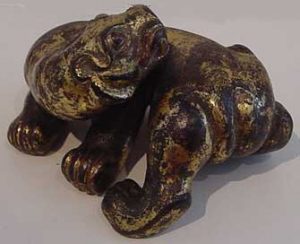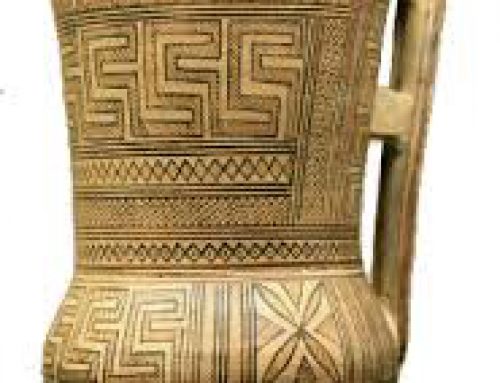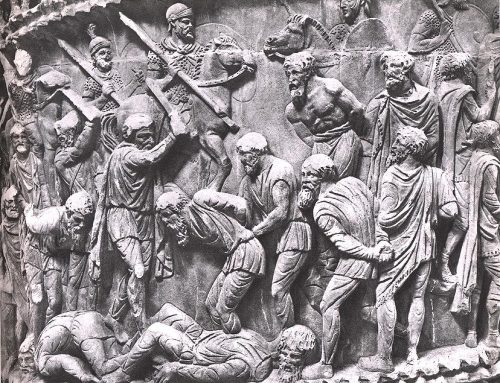
Han art: An embroidered Chinese boddhisatva (on cloth) wearing a pearl necklace
When was the Han Dynasty?
There were three big changes in Chinese art in the Han Dynasty. One of these changes happened about 200 BC, at the beginning of the Han Dynasty, at the time of the Mauryan Empire in India. Both of the other changes happened in the 100s AD, about the time of Jesus in West Asia or Caligula in Europe.
Qin Dynasty Chinese art
More Chinese art
The Han Dynasty
All our ancient China articles

Han art: Chimera, Musee Guimet, Paris
Embroidery and steel
The first big change, about 200 BC, was the invention of good steel. Most of this steel came from the Mauryan Empire, in India. Chinese blacksmiths made sharp, strong sewing needles out of the steel. Artists used the needles for embroidery. So embroidery became a lot more popular. Soon this sort of embroidery spread west along the Silk Road to West Asia and into Africa too.
Ancient and medieval steel
Steel sewing needles
The Mauryan Empire
Buddhism and Han art
The next big change was that many people in China converted to a new religion, Buddhism. Buddhism got started in India, and the Indian religious men who told Chinese people about Buddhism also showed Chinese artists Buddhist art.
What is Buddhism?
Buddhism in China
Indian art
Many Chinese artists began to draw pictures of the Buddha and his holy followers, the boddhisatvas, and carve sculptures of them. The style of these Buddhist paintings and sculptures was a lot like Indian art styles.
Paper and Chinese drawing
The other big change was that Chinese scientists invented paper. Instead of painting on silk the way they had in the Zhou and Qin Dynasties, Chinese artists started about this time to use paper (but they still used silk too).
Invention of paper
Where does silk come from?
Most of the time, Han painters didn’t use colors in their paintings. They did line drawings instead. They used thick and thin lines to show what was closer and what was farther away.

Han art: Servant, Musee Guimet, Paris
On the other hand, by the end of the Han Dynasty the old sacrificial bronzes that began in the Shang Dynasty seem to have been losing popularity – artists kept making them, but in the same old shapes, without any new experiments or new ideas.
Small clay figurines in Han art
Han Dynasty artists did make a lot of very lively small clay figures, both people and animals. Some were sculptures, and some were reliefs molded on to the new clay bricks.
What is clay?
Han Dynasty architecture
Did you find out what you wanted to know about Han art? Let us know in the comments.
Learn by doing: make a small figure out of clay
Go on to Three Kingdoms period art
Bibliography and further reading about Han Dynasty art:
The British Museum Book of Chinese Art, by Jessica Rawson and others (1996). Rawson is a curator at the British Museum, and she uses the collection of the British Museum to illustrate this book. Library Journal calls it “easily the best introductory overview of Chinese art to appear in years”.
Art in China (Oxford History of Art Series), by Craig Clunas (1997). Not specifically , but a good introduction to the spirit of Chinese art. Warning: this one is not arranged in chronological order. Instead, it has chapters on sculpture, calligraphy, and so on.
Chinese Buddhist Art, by Patricia Eichenbaum Karetzky (2003) .





I have recently purchased a Han dynasty clay figure of a seated robed man, in white, red and grey in colours. The base and sides is squared with a chris cross design to form triangles. I have been looking online to find something similar but am unable to. would you be able to confirm if it sounds familiar to artifacts you have seen?
Hi Joseph,
Sorry, but I can’t do appraisals – I don’t know enough about it, and also I think antiquities belong in museums where we can all enjoy them. But an antiques dealer who specializes in Han China would be able to answer your question.
woah very cool thank you for letting me know all of this goodstuff really good like that suger stuuf its real good
Thanks! I’m glad you liked it! Come back anytime!